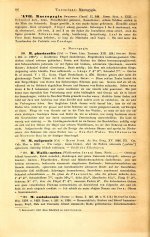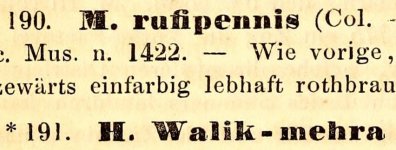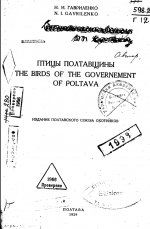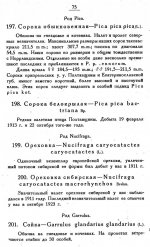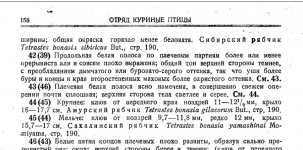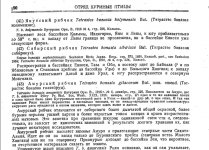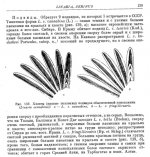Reichenbach's Vollst. Naturgesch., Handb. Spec. Ornithol., and associated works
Reichenbach's work is a mess, and it appears on the Web mostly under wrong dates, wrong titles, often with wrong coverts, and different parts were sometimes bound together in a rather arbitrary fashion.
This is what I currently have in my notes:
Reichenbach HGL. 1845-50. Die vollständigste Naturgeschichte der Schwimmvögel:
Aves Natatores. Oiseaux nageurs. Dresden & Leipzig.
Publication history suggested by
Meyer 1879:
- initial (= original plates, I to LXV?): 20 Feb 1845.
- synopsis: 1848.
- novitiae: 1 Dec 1850.
BHL has the plates [
here] (original + novitiae inserted among them). What Meyer calls the "synopsis" might be [
this], but I'm not fully sure.
Reichenbach HGL. 1846-51. Die vollständigste Naturgeschichte der Sumpfvögel:
Aves Grallatores. Oiseaux échassiers. Dresden & Leipzig.
Publication history suggested by
Meyer 1879:
- initial (= original plates): 3 Jun 1846.
- synopsis: 1848.
- novitiae: 1 Jun 1851.
BHL has the plates
here (original + novitiae inserted among them). What Meyer calls the "synopsis" might be [
this], but I'm not fully sure.
Reichenbach HGL. 1846-51. Die vollständigste Naturgeschichte der Wasserhühner u. Rallen:
Fulicariae et Rallariae. Les Foulques et les Râles. Dresden & Leipzig.
Publication history suggested by
Meyer 1879:
- initial (= original plates): 30 Dec 1846.
- synopsis: 1848.
- novitiae: 1 Jun 1851.
BHL has the plates
here (original + novitiae inserted among them). What Meyer calls the "synopsis" might be [
this], but I'm not fully sure.
Reichenbach HGL. 1848. Die vollständigste Naturgeschichte der Hühnervögel:
Aves Gallinaceae. Oiseaux gallinacées. Dresden & Leipzig.
Publication history suggested by
Meyer 1879:
- synopsis: Feb. 1848.
- initial (= original plates): 16 Jun 1848.
- novitiae: 1 Sep 1851.
BHL has the plates
here (original + novitiae inserted among them). I have never seen what Meyer calls the "synopsis".
Reichenbach HGL. 1849-53.
Avium Systema Naturale. Das naturliche System der Vögel mit hundert Tafeln grösstentheils Original-Abbildungen der bis jetzt entechten fast zwölfhundert typischen formen. Expedition der vollständigsten Naturgeschichte, Dresden & Leipzig.
Publication history suggested by
Meyer 1879:
- plates I to LI: 1 Dec 1849
- plates LII to LXI: 1 Mar 1850
- plates LXII to LXXXVI: 1 Jun 1850
- plates LXXXVII to C: 1 Aug 1850
- introductive text: 1 Oct 1852
BHL has the plates [
here] and the "introductive text" [
here] -- 1852 is the date that appears at the end of the Vorworte (
p. VIII); this is currently dated 1853 in H&M4.
Reichenbach HGL. 1851. Handbuch der speciellen Ornithologie.
Alcedineae. The King-fishers.--Les Martin-pêcheurs.--Die Eisvögel. Dresden & Leipzig.
Publication history suggested by
Meyer 1879:
- 1 Dec 1851
BHL has the text [
here] and the plates [
here].
Reichenbach HGL. 1852. Handbuch der speciellen Ornithologie.
Meropineae. The Bee-eaters.--Les Guêpiers.--Die Bienenfresser. Dresden & Leipzig.
Publication history suggested by
Meyer 1879:
- 1 Mar 1852
BHL has the text [
here] and the plates [
here].
Reichenbach HGL. 1853. Handbuch der speciellen Ornithologie.
Scansoriae. The Climbers.--Les Grimpeurs.--Die Klettervögel.
A. Sittinae. Dresden & Leipzig. The Grimpars.--Les Sitteés.--Die Baumkleber. Dresden & Leipzig.
Publication history suggested by
Meyer 1879:
- 1 Aug 1853
BHL has the text [
here] and the plates [
here].
Reichenbach HGL. 1853. Handbuch der speciellen Ornithologie.
Scansoriae. The Climbers.--Les Grimpeurs.--Die Klettervögel.
B. Tenuirostres. The Suctorial-Birds.--Les Tenuirostres.--Die Dünschnäbler. Dresden & Leipzig.
Publication history suggested by
Meyer 1879:
- 1 Nov 1853
BHL has the text [
here] and the plates [
here].
Reichenbach HGL. 1854. Aufzählung der
Colibris Oder Trochilideen in ihrer wahren natürlichen Verwandtschaft, nebst SchlüsseI ihrer Synonymik.
J. Ornithol. 1, Extraheft: 1-24.
BHL has it [
here].
Reichenbach HGL. 1854. Handbuch der speciellen Ornithologie.
Scansoriae. The Climbers.--Les Grimpeurs.--Die Klettervögel.
C. Picidae. The Woodpeckers.--Les Pics.--Die Spechte. B. Tenuirostres. The Suctorial-Birds.--Les Tenuirostres.--Die Dünschnäbler. Dresden & Leipzig.
Publication history suggested by
Meyer 1879:
- initial (plates): 27 May 1854
- text: 1 Oct 1854
BHL has the text [
here] and the plates [
here].
Reichenbach HGL. 1855.
Trochilinarum enumeratio, ex affinitate naturali reciproca primum ducta provisoria. F. Hofmeister, Lipsiae.
Reichenbach HGL. 1855-57.
Trochilinae. [Dresden & Leipzig.?]
Publication history suggested by
Meyer 1879:
- plates: 18 Jul 1855 to 12 Jan 1857
- Trochilinarum enumeratio (text): 18 Jul 1855
NB: Enumeratio is presented as a revised version of the paper that Reichenbach published in J Ornithol in 1853. No family group name appear to be new.
BHL has the Enumeratio [
here], but not the plates AFAIK. There are plates in Google Books under a wrong title [
here] and [
here].
Reichenbach HGL. 1846-62. Die vollständigste Naturgeschichte der Tauben und taubenartigen Vögel.
Columbariae. Les Pigeons, les Pénélopes et les Hoccos. Dresden & Leipzig.
Publication history suggested by
Meyer 1879:
- synopsis: 1847.
- initial (= original plates): 16 Jun 1848.
- novitiae: 1 Oct 1851.
- text: 1862, in two
Hälftes; second part (newly discovered species and addendum) after 1 Jul.
I have never seen what Meyer calls the "synopsis".
BHL has the 1848-51 plates [
here] and first part of the text [
here] -- this is now dated 1861 in H&M4. The text is 162 pp. long, and ends with an announcement: "Die systematische Uebersicht, die Aufzählung der Gattungen und Arten, die Synonymik und die Abbildungen der neuentdeckten Arten, folgen als Novitiae."
The publication of the second part was announced in
Arch. Naturgesch. [
here]: ""Neuentdeckte Taubenvögel" 9 Tafeln mit 98 Abbildungen (p.160-206)." Presumably this is where the
Walik-mehra is hiding?






